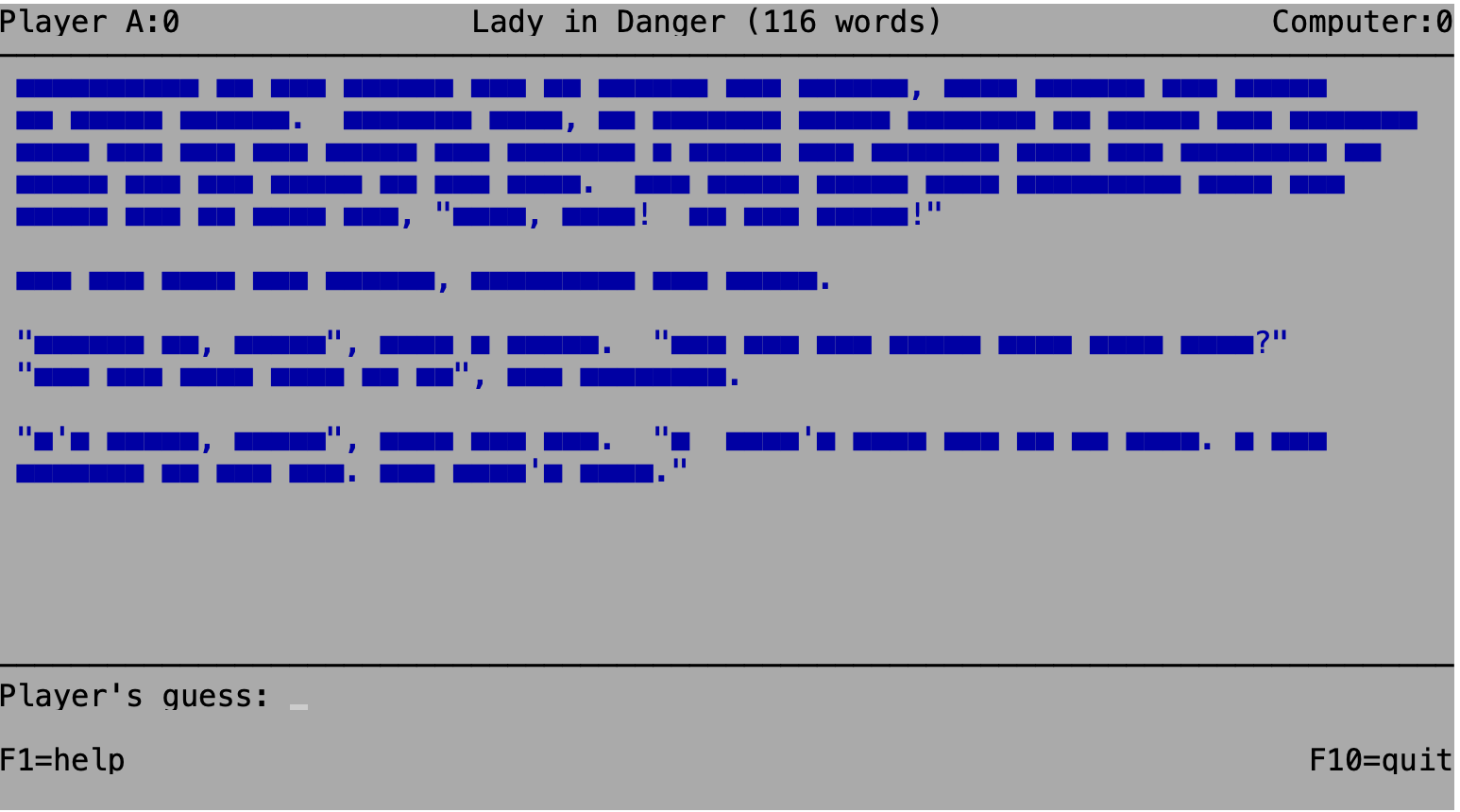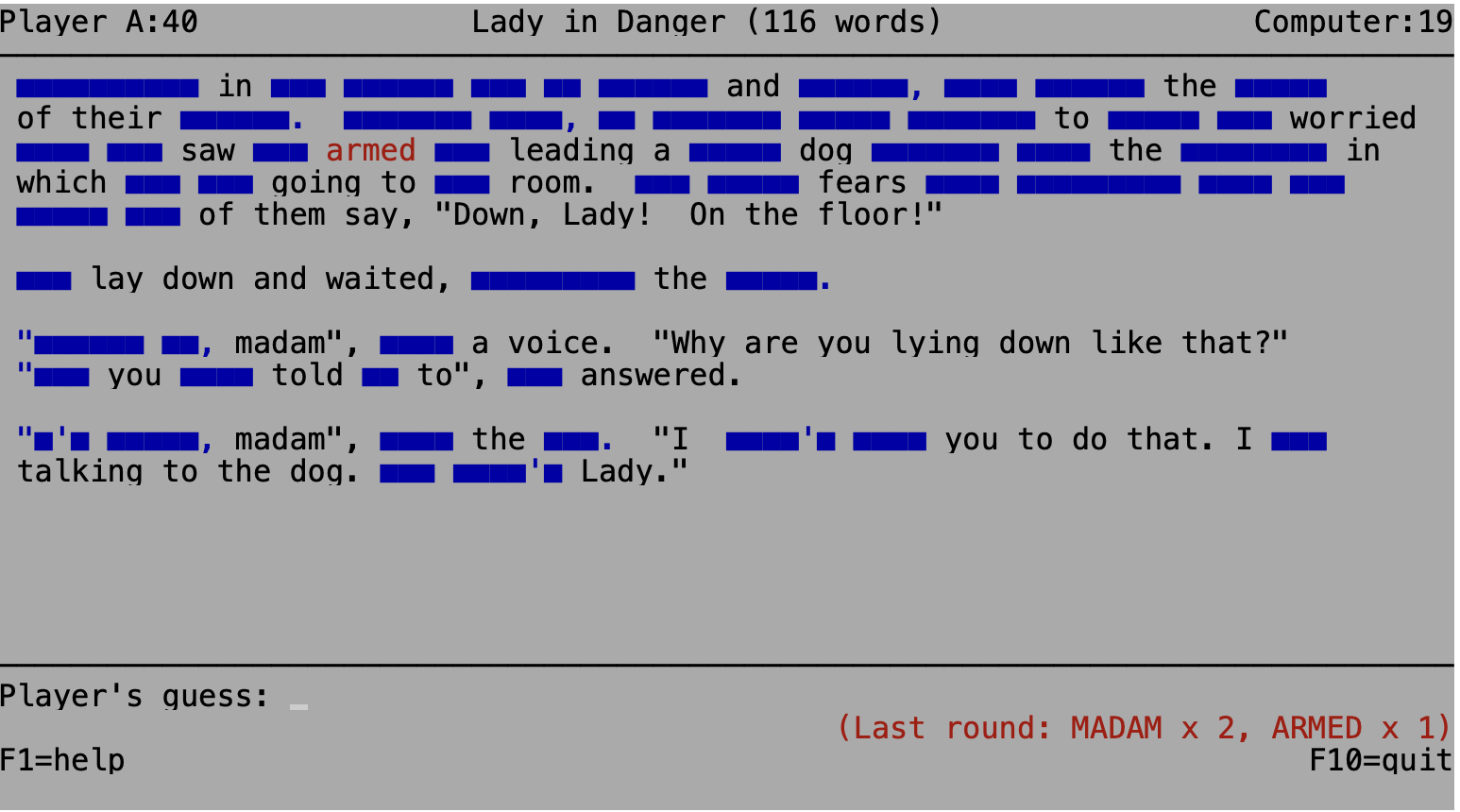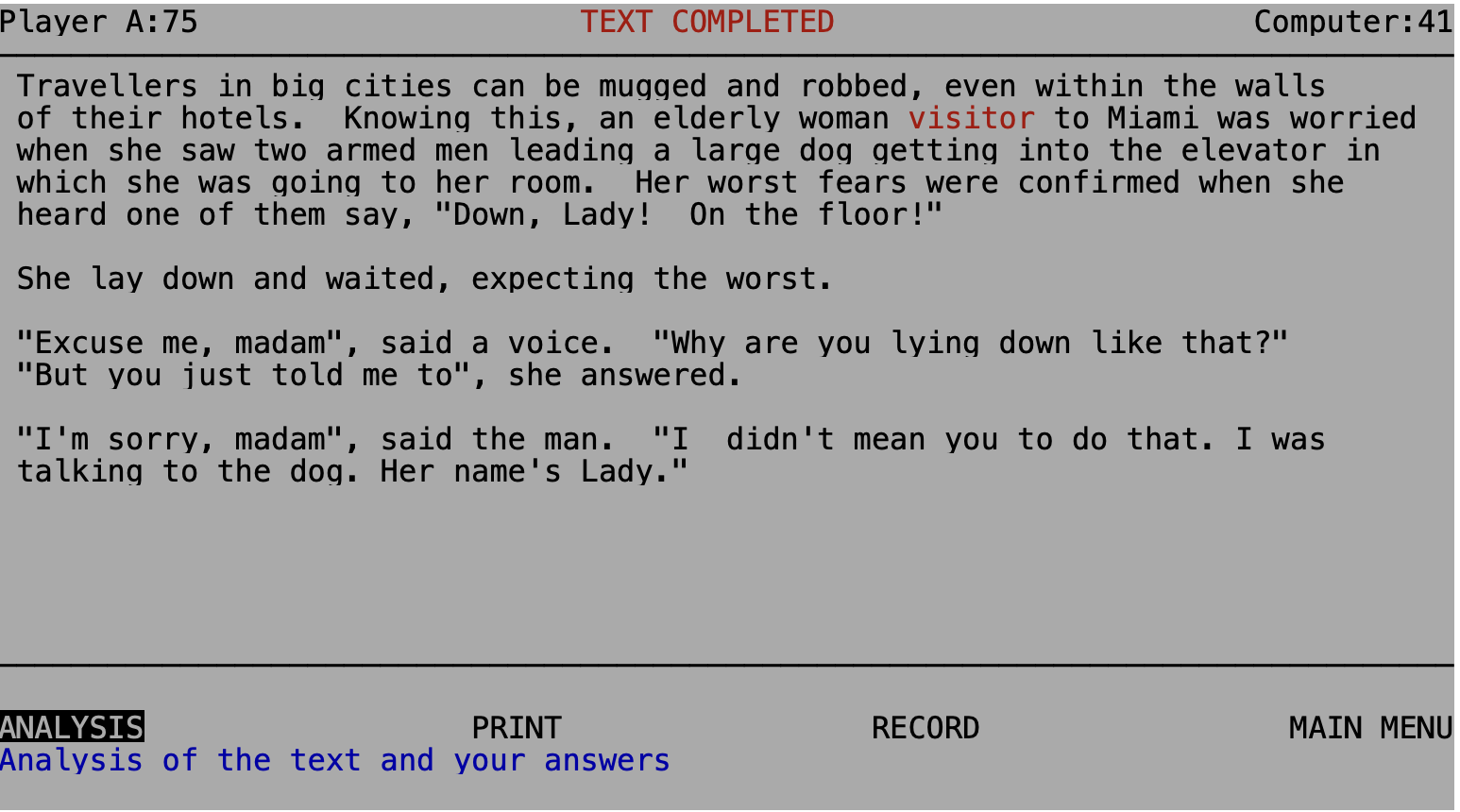Introduction: I had originally intended to cover in detail the experimental work done by just one of my students and offer this as a joint paper. In the event, since I am on the point of retiring and am not likely to be giving many more academic papers, I decided to widen the scope and cover all the research work that has been done on the STORYBOARD and ECLIPSE programs by my graduate students over the last ten years.
Text reconstruction is not a form of exercise unique to CALL; plenty of gapfill and re-ordering activities exist in paper versions. What the computer makes possible is unlimited immediate feedback, which allows a much richer use of guesswork. I sometimes express this in the slogan: the computer puts the trial back into trial and error.
We can mutilate texts in a variety of ways and let learners attempt to find the sense that has been concealed, to behave like the code-breakers of Bletchley Park, using existing linguistic knowledge and world knowledge to discover meaning. Basically, there are four ways of mutilating text:
The elements that you do this with can be at various levels: letters in words, words in sentences, phrases in sentences, sentences in paragraphs, paragraphs in text, and the process can be partial or total. The HANGMAN game is total deletion of letters in a word or phrase; anagrams are total re-ordering of letters in word or phrase, and so on. ECLIPSE is total deletion of words in text, and although a form of blackboard ECLIPSE has been demonstrated by Mario Rinvolucri, the natural habitat of the total deletion activity is on a computer.
In the ECLIPSE family of programs a text is blanked out, leaving just the title and a blue square to represent each letter in the body of the text:

The learners guess the words one at a time in any order. Words found are put in wherever they occur. (This is a type-replacement activity rather than a token-replacement activity, which was the form taken by its parent, Tim Johns’s TEXTBAG, in which you had to “buy” single words from a masked out text with the object of answering a question.)

As words are guessed the impossible-seeming task becomes much more feasible, especially if the game is being played as here in challenge mode with the human and the computer alternating word entries.

One can play in several different modes, as a solo player, in competition with another student or, as in this example, challenging the computer, which will enter words alternately, never making a mistake but being biased towards low-scoring high information singletons (usually content words) while the human player can score well with frequently occurring grammar words.

Tim Johns developed TEXTBAG in 1980, and released the complete source code in Sinclair BASIC for the Spectrum, then fairly widely used and understood. This appeared in Computers in Language Teaching by Higgins and Johns published by Collins in 1984. I wrote the first version of ECLIPSE, then called STORYBOARD, in 1981, first for a Sharp CP/M machine, then for the Spectrum, then for MSDOS, and Chris Jones adapted it for the BBC B and Apple II. The version for MSDOS was published by an American company under the name RHUBARB. Similar programs started appearing in 1984, Developing Tray, Quartext, Cloze encounters of the third kind, Fun with texts, and several more. Each tried to add a feature of its own. Quartext included a wild west game in which your words could be shot down by a six-shooter; Developing Tray had letter-buying, and later versions of STORYBOARD incorporated sound files. The main extra I put into ECLIPSE was selective deletion or display of specified parts of speech, and a wide range of help options. The program achieved a modest commercial success, with the strongest encouragement coming to me from the government of Austria when they adopted the program for all schools nation wide and applied it in a range of languages including Latin.
It has been widely observed that the program engrosses most learners and seems to lead to intensive thinking and prolific guessing. Scrimshaw (1993) describes several small scale pieces of research carried out on native speakers in British schools. There are anecdotal accounts of ECLIPSE’s success, such as that in Moore’s 1986 book. Moore describes the use of the version called Developing Tray, created by Bob Moy for English schools under a government funding scheme. Moore, by the way, erroneously says that the program concept was “the brainchild of Bob Moy” (p. 52). Just to put the record straight, Bob Moy was shown the first version of STORYBOARD by his colleague Isobel Cunningham who had been shown it by me in the British Council office in 1981. Moy made several modifications, such as options to buy every occurrence of a letter and the feature called bisques, i.e. words that were blocked from the standard help features and had to be guessed as whole words, but it remains the brainchild of Tim Johns and me.
What Moore says (p. 53/4) is “I have been surprised at the words which have been predicted which I had felt in advance would be beyond the limits of the pupils’ vocabulary. ... Another spin-off came from the fact that the end-of-lesson bell interrupted our deliberations, and we had to return to the text two days later. Knowing the limited memory span of my charges, we started from scratch again; it was stunning to find that many of the pupils could recite the parts of the passage we had uncovered two days before almost word-for-word and that they had been considering some of the more difficult gaps since the previous lesson. This was in complete contrast to the normal procedure teachers have to carry out when a reading activity has been interrupted. ... and the ensuing discussion about the passage was undertaken with enthusiasm and a much greater insight into its meaning, I’m sure, than would have been in evidence if I had presented it in the traditional way.”
This text might have been encouraging for me as the originator, but it was frustratingly anecdotal. How, I wondered, could we secure some evidence. “Insight into meaning” might be too intangible for the resources I could draw on, but memory and retention seemed more amenable to counting.
The first academic evaluation of a total deletion program was reported on in Legenhausen and Wolff (1990). They used a verbal reporting protocol and classified strategies into a range of text dependent and text-independent strategies on the basis of the reports, concluding that: The program in general promotes the activation of a large number of highly diversified problem-solving strategies. As STORYBOARD confronts the learner with a linguistic problem-solving task it is no wonder that he/she chooses to employ linguistic problem-solving strategies. There can be no doubt that in choosing these problem-solving strategies, the informant activates a high amount of explicit and partly implicit knowledge. We can further assume that implicit knowledge will, to a certain extent, be transformed into explicit knowledge (via successful hypothesis testing), thus perhaps making one’s linguistic knowledge more readily and more variably accessible. The question, however, remains whether the activation of this knowledge contributes to their language learning in that it improves their productive and receptive L2 competence. We rather tend to conclude that the activation of isolated bits of language knowledge detached from the overall context of language production or comprehension does not substantially further the learner’s productive and receptive abilities. ... We tend to believe that a foreign language is learned more effectively when it is used in a more purposeful way.
If Legenausen and Wolff are right in their last point, then it is bad news for people who create the kind of text manipulation activities represented by ECLIPSE, and far worse news for the writers of drill-and-practice material based on isolated sentences. In discussing their work, Brett (1994) suggests that the place for text reconstruction work is as one component of a battery of tasks in a multimedia learning package. With a tiny bit of cynicism about the term multimedia, I would agree strongly with this. There is no question of wanting people to do a majority of their learning by playing text reconstruction games.
However, I would like to enter two caveats, not against Legenhausen and Wolff or Brett whose work is sensible and balanced, but against those who take up a more extreme position and who I sometimes think of as the communicative police. They are the ones who can approve only those class activities which simulate a real-life meaningful exchange between native speakers. I would ask them first, what hard evidence is there of learning occurring in simulations, debates and other more communicative or “purposeful” activities? Obviously there is experience, but how is it internalised and is it retained? Secondly, why should we not describe the decryption of mutilated text as purposeful, or even “authentic”? In real life we sometimes have to make sense of degraded text, newspaper columns where the first word of each line is missing, books with missing pages, answer-machine messages with distortion or loud background hiss. We also relish such activities for play, in crossword puzzles and games. Of course the reconstruction of mutilated text is not communicative in the sense of being an exchange of meaning carried out for a non-linguistic reason. It is not done to find out a train time or even to make a friend. Those are the grounds on which the communicative police sometimes seem to want to step in and restrict it or even ban it altogether.
Whenever my students have taken on ECLIPSE as a subject for small-scale research projects or dissertations, I have been able to prepare for them versions which log all the keystrokes and record the time lapses between all events. Logging is, perhaps, an under-used resource; if the computer is capable of keeping a comprehensive record, it seems a pity not to make use of this information, provided of course that the candidates whose performance is studied know what is happening. I am strongly opposed to clandestine monitoring of students.
The first research done under my supervision on the program was by Cristina Poyatos Matas in Bristol in 1991, and this was reported on in a joint paper we gave at the IATEFL Conference in Exeter that year. What Cristina did was to include some bi-lingual texts, the first half in Spanish and the second half an English translation of the same text. British learners in intermediate Spanish classes played the game in CHALLENGE mode, with the machine set to supply mainly Spanish words or mainly English words on different runs. She found, predictably, that the appearance of a known Spanish word was more likely to prompt an immediate guess at an English translation than vice versa but, apart from that, the learners worked more in the target language and tried to complete that part before the English even though the English might have been easier.
In 1996 Nicholas Chatzigeorgiou used a version of the program onto which had added a timer display bar and the facility to set time limits based on the length of the texts. He was investigating the effects of time pressure on performance. What he found was that the imposition of time limits diminished performance but seems to have increased enjoyment, certainly as far as was reported in questionnaires.
In 1997 Intira Limsongprot, a student from Thailand, used a logging version of ECLIPSE in a project which measured recall. Using eight students, grouped into two pairs at low intermediate level and two at advanced level, and reversing the order of tasks within the pairs, she had the pairs work on two texts, and then recalled them for a further session two days later in which they did the same two texts and two further texts on related but different subject matter. Her very good work failed to establish the strong recall effect that Moore noted, though do not forget that Moore was observing native speakers. Intira’s low-level group used a lot of blind guessing for content words, and their performance gained when they were given the task after the two-day interval; it could hardly have failed to in view of the low base. Meanwhile the high group showed little mathematical gain, but a careful examination of what they did brought out some interesting points. First of all, where previously they had tended to guess uninflected forms, they were now entering inflected forms directly, touching rather than touch. Secondly, they were entering synonyms. Where the text they had solved previously had contain rescue, they now tried save, and for injure, damage. There was obviously some semantic recall, but the more salient and less context-restricted form was being tried first, and this accounted for much of the failure to show improvement in the raw scores.
Maria Maraki is the most recent person to tackle this area. She again used a straightforward logging version with nine students, looking for evidence of different strategies in relation to content and function words. That work is still held up in the marking process, but will probably not yield much that was not shown in Intira’s work, partly because a programming error, for which you can blame me, failed to eliminate the randomiser, so that the subjects did not get comparable tasks.
I think one can have reservations about any or all of these searches for what is quantifiable. When people ask me what ECLIPSE is for, I sometimes answer that I am the last person to know. It is what learners and teachers decide to use it for. To illustrate this I recall that Tony Williams told me that he had seen the program in use successfully at a withdrawal unit in Scotland, a special school for children whose attention span was too short for them to cope with ordinary lessons non-disruptively. With ECLIPSE they were able to concentrate on one task for fifteen minutes or more. I wrote it for my own students, intelligent and well motivated young adults with faulty English. I find it used by 10-year-olds with learning problems but no problems with control of English. I also know, by the way, that the program is in use in at least one prison.
So, is ECLIPSE for teaching? for reinforcement? for preparatory work? There is a danger in seeing teaching and learning as balanced parallel processes. Teaching in this case refers to the provision of the text reconstruction software and the entering of suitable texts; we are not talking about constant human intervention. But even with this sense of teaching, we may feel that we have to justify it by pointing to a matching gain in language control. The learner, having invested time and concentration, must be rewarded with so many words now understood, so many grammar patterns internalised. The fallacy here is to see teaching and learning both as gradualisms. Teaching is ordered and progressive. But learning is not. Language is littered with metaphors for learning and understanding which emphasise its suddenness:, it clicked, the penny dropped, it fell into place, it came to me in a flash. Learning is a parallel, not a serial process, and it does not have to occur when teaching occurs. A particular point made in a lecture may be understood hours, weeks or years later. To maximise the understanding we have to enrich the learning experience by providing as many parallel threads as possible, in the hope that more of the flashes of learning can occur. Unfortunately this seems to be something that is not well understood in government by all those people who now insist on measuring the hours and minutes we devote to our teaching in the belief that they are counting the hours and minutes of learning that result. As I retire this year from my paid position in a university, I look forward to moving from the quantitative to the qualitative in the research I do.
Brett, Paul (1994). “Using text reconstruction software.” ELT Journal. 48, 4. P. 329 - 334.
Chatzigeorgiou, Nicholas (1996). The effects of working to time limits in a text reconstruction task. Unpublished M Sc dissertation. Stirling
Higgins, John and Johns, Tim (1984). Computers in Language Learning. Collins
Higgins, John and Poyatos Matas, Cristina (1992). “What happens in ECLIPSE?” Paper given at the IATEFL Conference, Exeter 1992. Reprinted in Higgins (1995).
Higgins, John (1995). Computers and English language learning. Intellect Books.
Legenhausen, Lienhard and Wolff, Dieter (1990). “CALL in use--use of CALL; evaluating CALL software.” System, 18, 1. p. 1 - 14.
Limsongprot, Intira (1997). Problem solving and recall; using the text reconstruction software ECLIPSE. Unpublished M Sc dissertation, Stirling.
Maraki, Maria (2000). Strategies used in the ECLIPSE program. Unpublished M Sc dissertation. Stirling.
Moore, Phil (1986). Using computers in English; a practical guide. Methuen. P. 52 - 55.
Poyatos Matas, Cristina (1991). Evaluation of a computer program as a language learning aid. Unpublished M Ed. dissertation. Bristol.
Rinvolucri, Mario (1984). “Computer ideas for the chalkboard classroom.” Practical English Teacher 5 (4), p. 19 - 20
Scrimshaw, Peter (1993). “Text completion programs”. In Language, classrooms and computers, ed Scrimshaw. Routledge. P. 130 - 144.